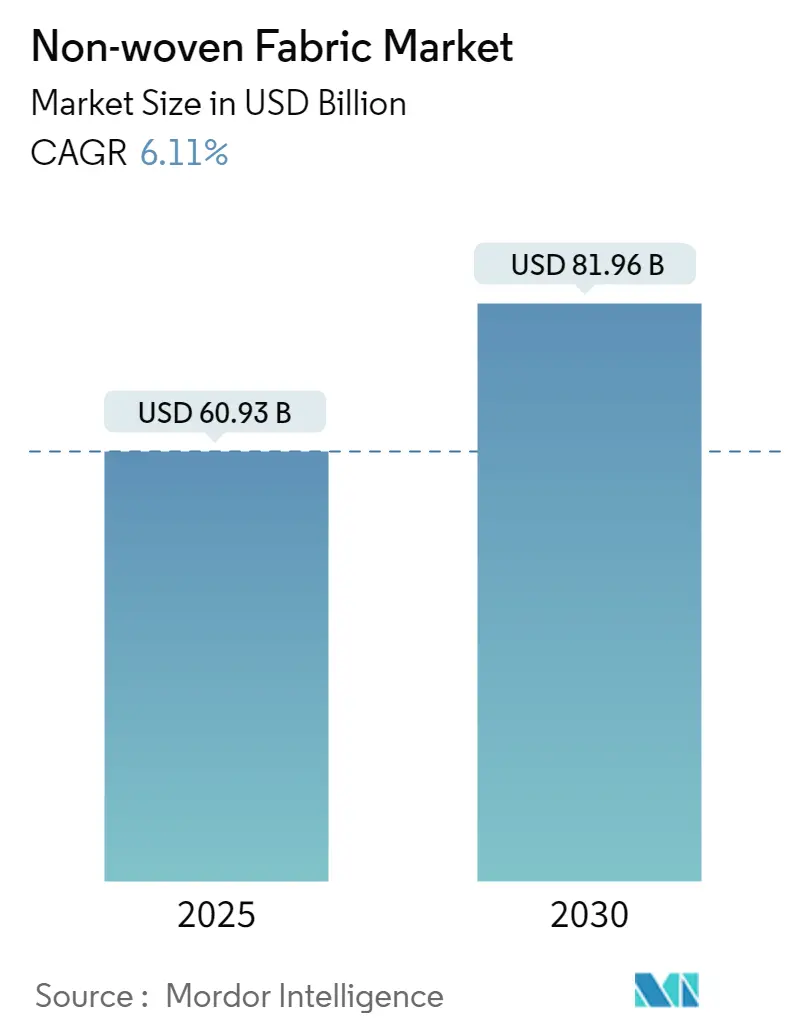
| Study Period | 2019 - 2030 |
| Market Size (2025) | USD 60.93 Billion |
| Market Size (2030) | USD 81.96 Billion |
| CAGR (2025 - 2030) | 6.11 % |
| Fastest Growing Market | Asia Pacific |
| Largest Market | Asia Pacific |
| Market Concentration | Low |
Major Players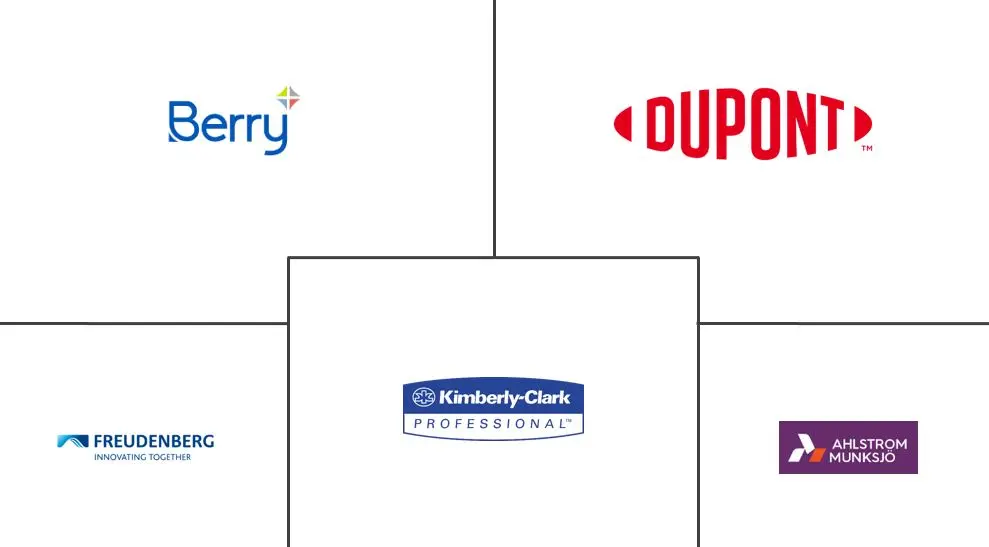
*Disclaimer: Major Players sorted in no particular order |
Non Woven Fabric Market Analysis
The Non-woven Fabric Market size is estimated at USD 60.93 billion in 2025, and is expected to reach USD 81.96 billion by 2030, at a CAGR of 6.11% during the forecast period (2025-2030).
The impact of the COVID-19 pandemic was minimal on the growth of the non-woven fabric market. As governments provide economic packages for SMEs and other benefits, consumers worldwide are now focussing on essential commodities and personal protective equipment.
Over the short term, the growing application base in the healthcare and personal care industry, along with increasing demand for electric vehicles, is expected to drive the market studied.
However, the low durability and strength of the fabric could hamper demand for non-woven fabric in the market.
On the other hand, increasing construction activities in the US and other emerging economies across the Asia-Pacific region could likely provide future opportunities for the non-woven fabric market.
Asia-Pacific dominated the global market, and the increasing application and demand from industries like construction, healthcare, etc., majorly drive the demand for non-woven fabric.
Non Woven Fabric Market Trends
Increasing Demand from the Healthcare Industry
- Non-woven fabric is used to make various products in the healthcare industry, such as surgical gowns, aprons, drapes, face mask components, and wound dressings. They are also used in hygiene products, such as sanitary towels, sanitary napkins, tampons, baby diapers, and napkin liners.
- There has been a rise in various kinds of hygiene products in recent times due to the spread of various diseases and the increasing adoption of female hygiene products in various countries.
- According to the report released by the National Family Health Survey in 2022, around 77.6% use a hygienic method such as sanitary pads for menstrual protection. With the increase in the penetration rate of sanitary care products, owing to the increasing hygiene precautions, the market for non-wovens in the country is expected to grow rapidly.
- In addition, various companies are investing in the production of eco-friendly sanitary napkins due to raising environmental concerns. In 2023, Niine Sanitary Napkins, a major manufacturer of premium and affordable hygiene solutions in India, launched PLA-based biodegradable sanitary pads that are CIPET-certified.
- According to SDMA, in the United Kingdom, the total cost of wound management is estimated to be around EUR 8.3 billion (USD 9.7 billion). Around 67% of it is spent on managing unhealed wounds, potentially driving the demand for non-woven fabric in the market. The NHS manages around 7% of the world's adult population, which is equivalent to 3.8 million patients, every year.
- In addition, various companies are setting up manufacturing plants for bio-based diapers. In 2023, ANDRITZ started a bio-based diaper manufacturing plant in Bully Les Mines, France. The plant is equipped with special technologies to produce both traditional and bio-based baby diapers, supporting Naturopera in its efforts to become a leading producer of a new generation of sustainable diapers.
- All these factors are expected to have a positive impact on the demand for Non-Woven fabric in the healthcare industry during the forecast period.
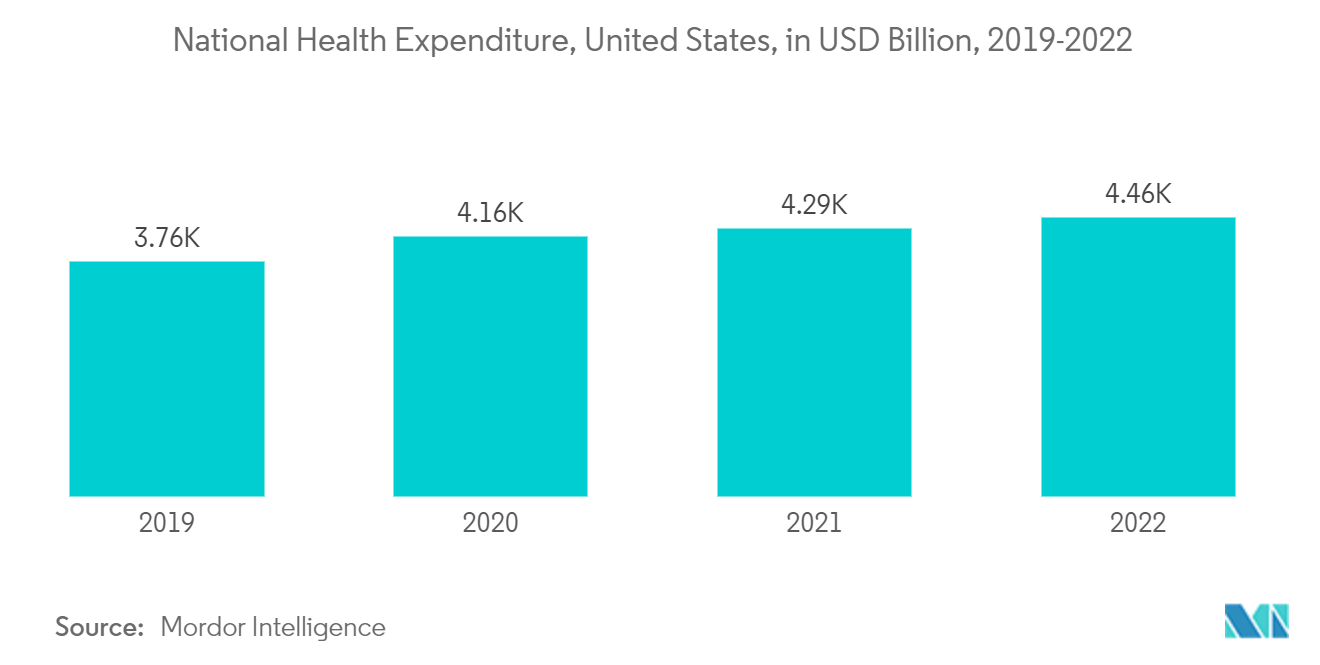
Asia-Pacific is Expected to Dominate the Market
- Asia-Pacific is expected to be the largest consumer globally, owing to the commissioning of additional capacities and an increase in the production of non-woven fabric in the region. In terms of consumption and production of non-woven fabric, China held the largest share globally.
- The textile industry in China is booming, with increasing investments and government support. However, textile and apparel makers are experiencing slow growth due to various economic factors. For instance, in 2023, textile production in China was around 32.58 billion meters, according to the latest data released by the National Bureau of Statistics of China. The average monthly production of textiles in China was around 2.72 billion meters in the past year.
- Non-woven Fabs are widely used in the manufacture of electronic components such as batteries and capacitors. They are used as separators among the various layers of materials to prevent short circuits and improve device performance.
- Japan has been one of the major producers of consumer electronics in recent times. According to the data released by the Japan Electronics and Information Technology Industries Association (JEITA), the total production of electronic goods in the first eleven months of 2023 accounted for JPY 9.76 trillion (USD 66.28 billion) compared to JPY 10.06 trillion (USD 72.61 billion) in 2022.
- In the Construction industry, Non-woven fabrics are used for greenhouse shading, insulation, modified bitumen roofing, pavement overlays, roadway reinforcements, roofing components, and other such applications.
- China has the largest construction market in the world, encompassing 20% of all construction investments globally. China is expected to spend nearly USD 13 trillion on buildings by 2030, creating a positive market outlook for the modular construction market.
- Furthermore, the housing authorities of Hong Kong launched several measures for the construction of low-cost housing. The officials aim to provide 301,000 public housing units by 2030.
- All the factors mentioned above, in turn, are projected to drive the market at high rates in the Asia-Pacific region, owing to the rapid growth of end-user industries.
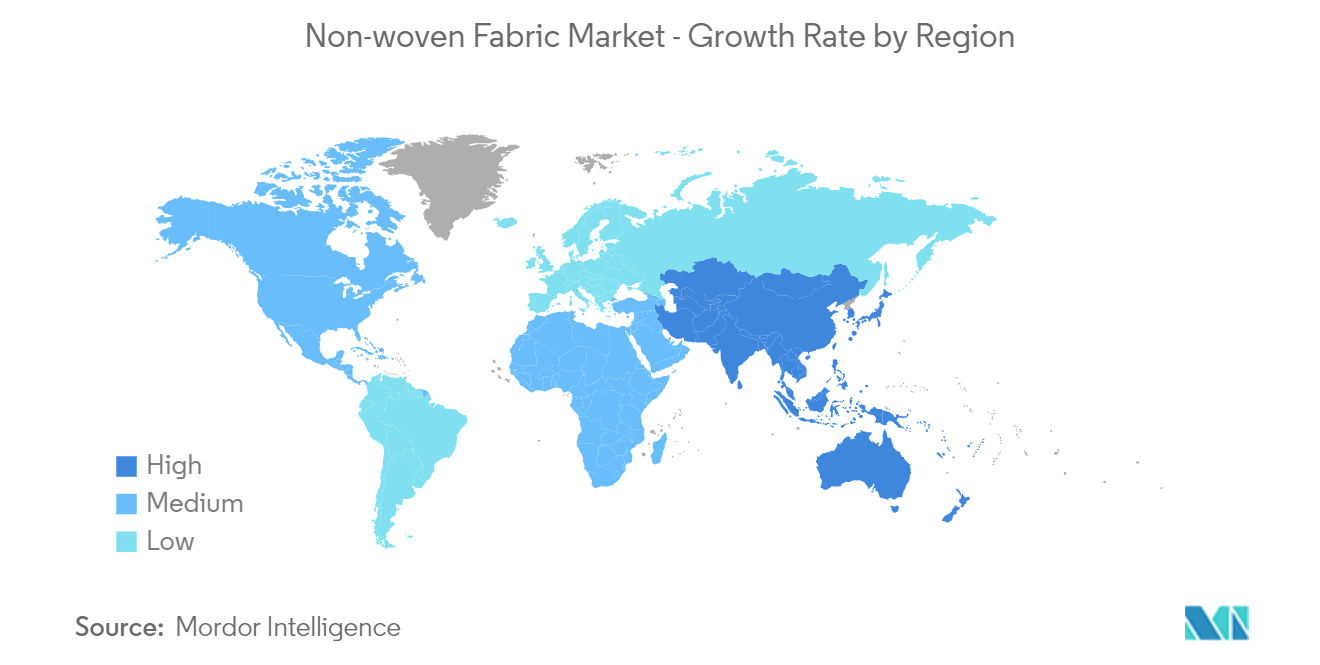
Non Woven Fabric Industry Overview
The non-woven fabric market is fragmented in nature. The major players in the studied market (not in any particular order) include Berry Global Inc., Freudenberg Group, Ahlstrom-Munksjö, KCWW, and DuPont, among others.
Non Woven Fabric Market Leaders
-
Berry Global Inc.
-
Freudenberg Group
-
KCWW
-
DuPont
-
Ahlstrom-Munksjö
- *Disclaimer: Major Players sorted in no particular order
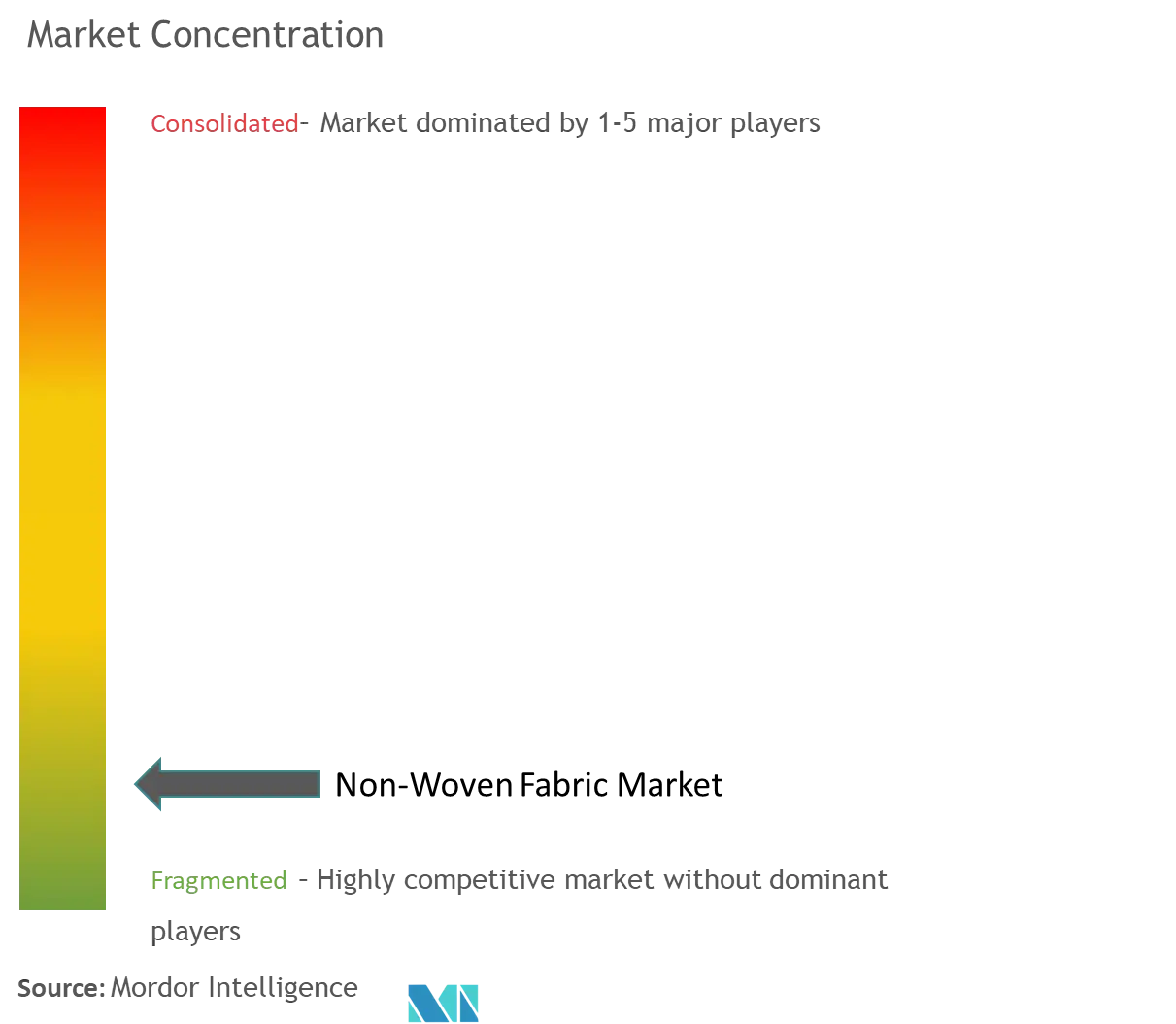
Non Woven Fabric Market News
- August 2022: Willacoochee Industrial Fabrics, Inc. (WINFAB), one of the leading manufacturers of geosynthetic and erosion control products in the United States, announced its investment into a new state-of-the-art nonwoven geotextile manufacturing production line in Nashville, GA. The production line was anticipated to begin operation by the second quarter of 2023.
- June 2022: Asten Johnson announced the creation of its new division named AJ Nonwovens. The global industrial textile manufacturer stated that it intends to increase production capacity and improve speed in the North American market through this move.
Non Woven Fabric Industry Segmentation
Non-woven fabrics are broadly defined as sheet or web structures bonded together by entangling fiber or filaments mechanically, thermally, or chemically. They are flat, porous sheets made directly from separate fibers or molten plastic or plastic film.
The non-woven fabric market is segmented by technology, material, end-user industry, and region. By technology, the market is segmented into spun-bond, wet-laid, dry-laid, and other technologies. By material, the market is segmented into polyester, polypropylene, polyethylene, rayon, and other materials. By end-user industry, the market is segmented into construction, textile, healthcare, automotive, and other end-user industries. The report also covers the market size and forecasts for the market in 27 countries across the major regions.
For each segment, the market sizing and forecasts have been done on the basis of value (USD).
| Technology | Spun-bond | ||
| Wet-laid | |||
| Dry-laid | |||
| Other Technologies (Meltblown, and others) | |||
| Material | Polyester | ||
| Polypropylene | |||
| Polyethylene | |||
| Rayon (Viscose) | |||
| Other Materials (Cotton and other bio based) | |||
| End-user Industry | Construction | ||
| Textile | |||
| Healthcare | |||
| Automotive | |||
| Other End-user Industries (Agriculture, Insulation, Clothing, and other end-user industries) | |||
| Geography | Asia-Pacific | China | |
| India | |||
| Japan | |||
| South Korea | |||
| Malaysia | |||
| Thailand | |||
| Indonesia | |||
| Vietnam | |||
| Rest of Asia-Pacific | |||
| North America | United States | ||
| Canada | |||
| Mexico | |||
| Europe | Germany | ||
| United Kingdom | |||
| France | |||
| Italy | |||
| Spain | |||
| Turkey | |||
| Russia | |||
| NORDIC Countries | |||
| Rest of Europe | |||
| South America | Brazil | ||
| Argentina | |||
| Colombia | |||
| Rest of South America | |||
| Middle-East and Africa | Saudi Arabia | ||
| Nigeria | |||
| Qatar | |||
| Egypt | |||
| United Arab Emirates | |||
| South Africa | |||
| Rest of Middle-East and Africa | |||
Non Woven Fabric Market Research FAQs
How big is the Non-woven Fabric Market?
The Non-woven Fabric Market size is expected to reach USD 60.93 billion in 2025 and grow at a CAGR of 6.11% to reach USD 81.96 billion by 2030.
What is the current Non-woven Fabric Market size?
In 2025, the Non-woven Fabric Market size is expected to reach USD 60.93 billion.
Who are the key players in Non-woven Fabric Market?
Berry Global Inc., Freudenberg Group, KCWW, DuPont and Ahlstrom-Munksjö are the major companies operating in the Non-woven Fabric Market.
Which is the fastest growing region in Non-woven Fabric Market?
Asia Pacific is estimated to grow at the highest CAGR over the forecast period (2025-2030).
Which region has the biggest share in Non-woven Fabric Market?
In 2025, the Asia Pacific accounts for the largest market share in Non-woven Fabric Market.
What years does this Non-woven Fabric Market cover, and what was the market size in 2024?
In 2024, the Non-woven Fabric Market size was estimated at USD 57.21 billion. The report covers the Non-woven Fabric Market historical market size for years: 2019, 2020, 2021, 2022, 2023 and 2024. The report also forecasts the Non-woven Fabric Market size for years: 2025, 2026, 2027, 2028, 2029 and 2030.
Our Best Selling Reports
Non Woven Fabric Industry Report
Statistics for the 2025 Non-woven Fabric market share, size and revenue growth rate, created by Mordor Intelligence™ Industry Reports. Non-woven Fabric analysis includes a market forecast outlook for 2025 to 2030 and historical overview. Get a sample of this industry analysis as a free report PDF download.




